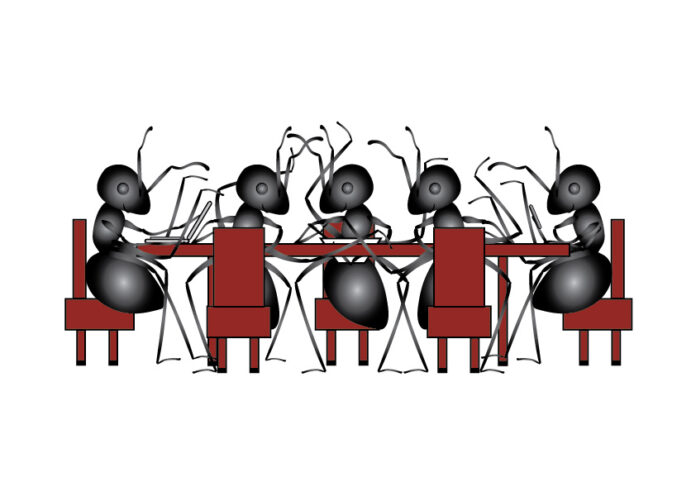A first study has shown how an जानवर society actively reorganizes itself to reduce the spread of रोग.
Generally speaking, high आबादी density in a geographical region is the biggest factor which contributes to faster spread of a disease. When populations become dense it causes overcrowding which then leads to decline in living conditions. This causes the rate of disease transmission to increase mainly due to frequent and close contacts between individuals. Such populations become breeding grounds for infectious agents like viruses and bacteria.
चींटी आबादी
चींटियों are organisms which thrive almost everywhere be it जंगलों or deserts and they live in large colonies or groups. Ants are known to be very social and this व्यवहार gives them huge advantage over insects or animals which exist solitary. An ant colony is organized in sub-groups based upon their age and the tasks which each of these groups need to carry out. There are mainly three types of ants in a colony – queen ant, females who are mainly ‘workers’ and males. Their main goal is survival, growth and reproduction. So, ant’s interactions with other colony members are not really random as one would assume. The queen ant is the most important as only it can lay eggs and is the only member of an ant colony who can produce new members. The ‘younger’ ants, also called ‘nurses’ look after the brood at the centre of the colony. While ‘older’ ants act like foragers who travel and collect food from outside and for this reason older ants are more exposed and vulnerable to pathogens. A pathogenic invasion can cause spread of a disease and could likely terminate the entire colony.
में प्रकाशित एक अध्ययन विज्ञान यह दर्शाता है कि जब एक रोग पैदा करने वाला रोगज़नक़ एक चींटी कॉलोनी में प्रवेश करता है, तो चींटियाँ अपनी कॉलोनी को एक आसन्न महामारी रोग से बचाने के लिए अपने व्यवहार को संशोधित करती हैं। वे अपनी रानी और उनके पूरे बच्चे को बीमारी की चपेट में आने से बचाते हैं और इसके लिए उन्होंने एक दिलचस्प 'रक्षा तंत्र' विकसित किया है। इस तंत्र का एक महत्वपूर्ण पहलू 'सामाजिक संगठन' है जो कॉलोनी के भीतर होता है। इंस्टीट्यूट ऑफ साइंस एंड टेक्नोलॉजी ऑस्ट्रिया और लॉज़ेन विश्वविद्यालय के शोधकर्ताओं ने एक 'बारकोड' प्रणाली का उपयोग करके इस अध्ययन को सामान्य परिस्थितियों में एक कॉलोनी के भीतर चींटियों के बीच बातचीत का ध्यानपूर्वक पालन करने और समझने के लिए किया, जब कोई बीमारी फैल रही हो। उन्होंने लगभग 2260 बगीचे की चींटियों पर डिजिटल मार्कर लगाए और हर आधे सेकेंड में कॉलोनी की छवि को इंफ्रारेड कैमरों ने कैद किया। इस पद्धति ने उन्हें आंदोलन के साथ-साथ प्रत्येक चींटी सदस्य की स्थिति और कॉलोनी के भीतर उनकी सामाजिक बातचीत का पालन करने और मापने में सक्षम बनाया।
चींटियों की रक्षा तंत्र
To initiate disease transmission, around 10 percent of older ants or foragers were exposed to fungal spores which spread very fast. A comparison of ant colonies before and post pathogen exposure was made. Clearly, ants quickly realized the presence of कवक spores and they subdivided themselves into groups and changed their interactions with each other. Nurses only interacted with nurses and foragers with only foragers and their interaction with each other was diminished. The entire colony of ants changed their response, even those ants that were not exposed to fungal spores. This can be seen as a preventive measure as it reduces the risk of disease spread. qPCR technique was used to quantify the number of spores carried by an ant as spores would amplify the targeted DNA molecule. A track was kept on the number of fungal spores. When ants changed their interaction, the pattern of fungal spores also kept changing which was noticeable in the readings.
यह देखना दिलचस्प था कि चींटी कॉलोनी अपने 'मूल्यवान सदस्यों' की रक्षा करती है जो योगदान दे सकते हैं - रानी, नर्स और युवा कार्यकर्ता - और उनका अस्तित्व अत्यंत महत्वपूर्ण था। विस्तृत उत्तरजीविता प्रयोग से पता चला है कि किसी भी रोगज़नक़ का भार पहले प्रदर्शन के 24 घंटे बाद सीधे बीमारी से मृत्यु और सहसंबंध के उच्च मूल्य के साथ सहसंबद्ध होता है। नर्सों की तुलना में वृद्ध या जंगली चींटियों में मृत्यु दर अधिक थी और सबसे मूल्यवान सदस्य - रानी चींटी - अंत तक जीवित थी।
यह अध्ययन चींटियों के दृष्टिकोण से एक बीमारी की गतिशीलता पर प्रकाश डालता है क्योंकि वे सामूहिक रूप से बीमारी फैलने के संभावित जोखिम को संभालते हैं। इसने स्थापित किया कि किसी बीमारी के प्रसार के दौरान जीवों के बीच सामाजिक संपर्क महत्वपूर्ण है। चींटियों पर शोध हमें उन प्रक्रियाओं को समझने में मार्गदर्शन कर सकता है जो जीवों के अन्य सामाजिक समूहों के लिए प्रासंगिक हो सकती हैं। हमें यह मूल्यांकन करने की आवश्यकता है कि रोग के जोखिम पर क्या प्रभाव पड़ता है और कौन से उपयुक्त नियंत्रण उपाय तैयार किए जा सकते हैं। जनसंख्या-व्यापी गतिशीलता अनिवार्य है जहां प्रतिरक्षा विज्ञान, रोग संचरण और जनसंख्या संरचना जैसे कारकों को ध्यान में रखा जाता है।
***
{आप उद्धृत स्रोतों की सूची में नीचे दिए गए डीओआई लिंक पर क्लिक करके मूल शोध पत्र पढ़ सकते हैं}
स्रोत (रों)
स्ट्रोयमेट एन एट अल। 2018 सोशल नेटवर्क प्लास्टिसिटी एक यूकोसियल कीट में रोग संचरण को कम करता है। विज्ञान। 362 (6417)। https://doi.org/10.1126/science.aat4793
***






































